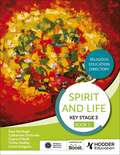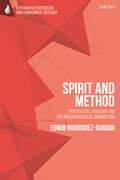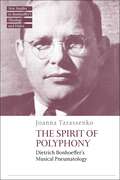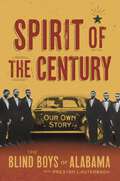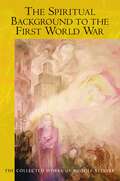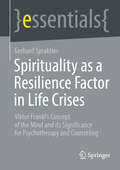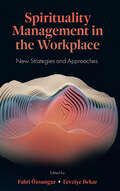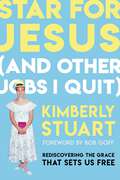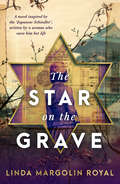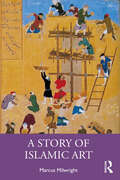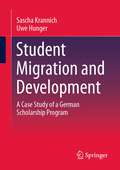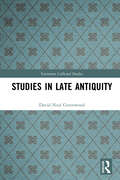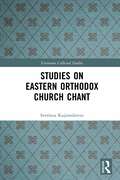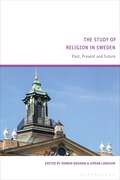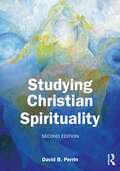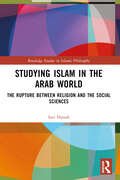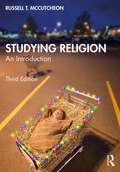- Table View
- List View
Spirit and Life: Religious Education Directory for Catholic Schools Key Stage 3 Book 2
by Paul McHugh Trisha Hedley Claire O'Neill Carol GregsonThis title has received an Imprimatur and has been endorsed by the Catholic Education Service for the new REDEncourage students to engage with Catholic Religious Education at Key Stage 3 and enable them to understand, discern and respond to key concepts and ideas.This accessible Student Book has been written by experienced teachers and diocesan advisors to support the new Religious Education Directory (RED). - Easily deliver engaging lessons with in-depth content and ready-made tasks for each branch of learning within the new curriculum- Teach with confidence, whatever your level of expertise, with comprehensive and reliable guidance to support both specialists and non-specialists- Build students' knowledge with clear content coverage, including topic overviews, annotated extracts from scripture and clear explanations of key terms- Deepen understanding and help students to engage critically with the content by working through the 'Understand', 'Discern' and 'Respond' tasks throughout - Consolidate previous learning with links between topics highlighted to encourage students to revisit and recap what they have already covered
Spirit and Method: Pentecostal Theology and the Pneumatological Imagination (T&T Clark Systematic Pentecostal and Charismatic Theology)
by Edwin Rodriguez-GungorOffers a generative and hospitable theological methodology rooted in the distinctives of pentecostal spirituality, enlivened by a Spirited imagination and opened toward critical, constructive, and conciliatory dialogue with the wider Christian tradition. This inter- and cross-disciplinary work is careful yet generous, drawing together of knowledge and wisdom from different domains-historical, philosophical, and theological-in ways recognizably pentecostal and effectively missional.The book begins with a description of the essence of pentecostal spirituality that holds true across the various pentecostalisms. Drawing largely on an innovative engagement with the insights of Rudolph Otto and an exploration of the dialectic between religious experience and theological development, this book contends for an identifiable but mysterious “something” that makes pentecostalism truly pentecostal-that is, something more than one might sum up in any set of peculiar practices, beliefs, or behaviors.The book also provides an overview of the intellectual history of English-speaking pentecostalism, specifying and assessing the movement's major philosophical underpinnings and socio-cultural motivations. Finally, funded by an explicitly pentecostal metaphysics, the book sets forth a significant and boldly original pneumatological theological methodology, shaped by discerning conversation with the works of Amos Yong, L. William Oliverio, Jr., Wolfgang Vondey, and Simo Frestadius, among others.
The Spirit of Polyphony: Dietrich Bonhoeffer's Musical Pneumatology (T&T Clark New Studies in Bonhoeffer’s Theology and Ethics)
by Rev Dr Joanna TarassenkoThis book re-examines how Bonhoeffer employs musical patterns of thought and language to a theological end. It outlines how the significance of Bonhoeffer's musico-theology has not been sufficiently recognised, and sets the stage for a rigorous re-examination. It becomes clear that through the lens of his musical metaphor of polyphony, Bonhoeffer demonstrates how his account of Christian formation contains a latent pneumatology. Tarassenko demonstrates that incorporation of this pneumatology is key in deepening one's understanding of Bonhoeffer. It allows the relationship between Christology and Christian formation in Bonhoeffer's thought to become fully realised. The appeal to polyphony articulates this pneumatology, as an indirect but nevertheless exceedingly successful means of contouring an account of the Spirit's work.
Spirit of the Century: Our Own Story
by The Blind Boys of AlabamaAn insider history of the Blind Boys of Alabama, the longest running group in American music, and the untold story of their world, written with band members and key musical colleagues. The Blind Boys of Alabama are the quintessential Gospel vocal group, and the longest-running musical institution in America. Their story intersects with pivotal moments and issues in American history and is an ideal prism through which to trace music, culture, history, and race in America. Spirit of the Century invites readers to follow along the Blind Boys&’ eight-decade journey together from a segregated trade school, through the rough and tumble indie record game and grinding tour schedule of the golden age of gospel, to starring in an iconic Broadway musical, performing at the White House for three presidents twice, collaborating with Tom Petty, Lou Reed, and Ben Harper, among others, singing the theme song for &“The Wire,&” and winning five Grammys. More than just a story of the Blind Boys' illustrious career, Spirit of the Century also sheds new light on the larger world of African American gospel music, its origins, and the colorful characters at its center. Though there have been several iterations of the group over the decades, Spirit of the Century rounds up all surviving members of the group as contributors to the telling of their own story, and a result, the book offers a unique and intimate perspective on the group's enduring success. Current drummer and road manager Rickie McKinney has been with the group throughout its renaissance, while guitarist Joey Williams, the group&’s sighted member, has been the eyes of the Blind Boys since 1992. Octogenarian Jimmy Lee Carter has a fascinating history, as a fellow student of the original but deceased Blind Boys Clarence Fountain, George Scott, Olice Thomas, Johnny Fields, J.T. Hutton, and Velma Traylor at the Talladega school. Carter is one of a few performers who have been in both the Blind Boys of Alabama and Mississippi. He fronts the Alabama group today as a classic quartet leader and fiery preacher. Along with extensive interviews of Fountain, these legendary musicians provide this book with the voice, firsthand perspective, and authenticity that bring their story the same inspirational power that you hear in their songs. Thought-provoking, heartfelt, and deeply inspiring, Spirit of the Century is a fascinating and one-of-a-kind read that you won't be able to put down.
Spirits of the Space Age: The Imagined World of Brazil's Valley of the Dawn
by Kelly E. HayesSince its inauguration in 1960, Brazil's capital city, Bras?lia, has become an internationally recognized center for eclectic forms of modern mysticism. Among the dozens of New Age, Spiritist, esoteric, and occult communities that have sprouted in the city and its environs, the most spectacular is the Valley of the Dawn (Vale do Amanhecer). Equal parts religious movement, enchanted city, utopian vision, and theatrical spectacle, the Valley of the Dawn is a unique psychic ecosystem. Community members consider themselves the spiritual descendants of an ancient race of extraterrestrials originally sent to galvanize humanity's cultural and spiritual evolution. Wearing dazzling garments that reference their past lives in different cultural eras, adherents perform daily ceremonies for karmic redemption and offer spiritual healing services free of charge to the public. The Valley of the Dawn was founded by a charismatic spirit medium called Aunt Neiva, a widowed mother of four who came to Bras?lia in 1957 to work in the construction of the new capital city. Over two decades, Aunt Neiva established a spiritual metropolis that today is home to over 25,000 people and the headquarters of a global religious movement with more than 800 affiliated temples worldwide. Spirits of the Space Age details the Valley's historical emergence, placing it within the context of mid-twentieth century Brazil, and explores its "imagined world" --the imaginative and collectively shared representations that foster a common sense of identity, meaning, and purpose among Valley members. Drawing on extensive ethnographic fieldwork, it offers a narrative portrait of a new religious movement as seen in and through the lives of Aunt Neiva, her most important collaborators, and contemporary adherents. By presenting a more complete picture of the Valley of the Dawn, this book counters the persistent media representations of the Valley as a cult. But it also illuminates how religious movements respond to their place and time even as they situate themselves in relationship to imagined otherworlds and times.
The Spiritual Background to the First World War
by Rudolf SteinerWith the unprecedented global conflict of the First World War as an overarching theme, Rudolf Steiner addresses timeless issues such as the search for harmony between peoples and nations, the development of the human capacity for love, the contemporary presence of Christ, and the questions of reincarnation and life after death. Speaking in the German city of Stuttgart during and after the war years, Steiner discusses the perpetual tension between East and West – particularly in relation to Europe. The war, he says, arose principally out of the Anglo-Saxon peoples' determination 'to exercise world-domination'. Knowing that Slavic culture is destined to be the precursor of the sixth cultural epoch, Western national interests resolved to make Eastern Europe – specifically Russia – 'the field for socialist experiments'. These events were aggravated by the failure of the Central European peoples in their own world-historical task, to 'rise to a broad sense of vision' as intermediaries between the two groups. Throughout, Steiner refers to the work of individual Folk Souls, but distinguishes them from the scourge of nationalism – especially when it is based on blood – whilst emphasizing the sovereignty of the individual human being. Although more than a century old, the enduring themes of these previously-untranslated lectures will resonate with many readers today. The main text is supplemented with an introduction by Simon Blaxland-de Lange, editorial notes and an index. Sixteen lectures, Stuttgart, Sept. 1914–March 1921, GA 174b
Spirituality as a Resilience Factor in Life Crises: Viktor Frankl's Concept of the Mind and its Significance for Psychotherapy and Counseling (essentials)
by Gerhard SpraktiesThis essential illustrates to psychotherapists and counselors the importance of spirituality for strengthening personal resilience. We live in often exhausting and fast-moving times. The 21st century began with a series of crises on a global scale: the terrorist attacks of 9/11, the financial crisis, climate change, the coronavirus pandemic and the war in Ukraine. Many media outlets today are true artists when it comes to describing unsuccessful lives. Anyone who is constantly preoccupied with negative news runs the risk of losing their inner mental balance. They are in danger of falling into a mood characterized by gloom and resignation. Experienced spiritual counselor and logotherapist Gerhard Sprakties shows how a deep spiritual foundation can help us to deal with these challenges in a constructive way.
Spirituality Management in the Workplace: New Strategies and Approaches
by Fahri Özsungur Fevziye BekarIn recent years, after realizing that personal beliefs and spiritual development are as important as mental strength, studies in the field of spirituality in the workplace have grown exponentially. The experts here provide conceptual frameworks and guidance by examining the subject in the light of current developments at multiple levels of analysis: individual, organizational, cultural, and in leadership. Furthermore, this book focuses on rapidly evolving business models: remote working, the cyber-workplace, social media, digitalization, etc – all accelerated by the COVID-19 epidemic. The concept of spirituality in the workplace can be harmful as well as beneficial. Employees who are spiritually attached to the workplace may ignore issues known as ‘organizational deviation’ (such as theft and corruption) by keeping the interests of the institution in the foreground. These ‘dark’ and ‘invisible’ aspects of spirituality in the workplace are also examined, with a special focus on identifying aspects of spirituality which can harm businesses. Spirituality in the workplace considers employees as a whole, in spirit, body, and mind.
Spirituality Management in the Workplace: New Strategies and Approaches
by FAHRI OZSUNGUR AND FEVZIYE BEKARIn recent years, after realizing that personal beliefs and spiritual development are as important as mental strength, studies in the field of spirituality in the workplace have grown exponentially. The experts here provide conceptual frameworks and guidance by examining the subject in the light of current developments at multiple levels of analysis: individual, organizational, cultural, and in leadership. Furthermore, this book focuses on rapidly evolving business models: remote working, the cyber-workplace, social media, digitalization, etc – all accelerated by the COVID-19 epidemic. The concept of spirituality in the workplace can be harmful as well as beneficial. Employees who are spiritually attached to the workplace may ignore issues known as ‘organizational deviation’ (such as theft and corruption) by keeping the interests of the institution in the foreground. These ‘dark’ and ‘invisible’ aspects of spirituality in the workplace are also examined, with a special focus on identifying aspects of spirituality which can harm businesses. Spirituality in the workplace considers employees as a whole, in spirit, body, and mind.
Star for Jesus (And Other Jobs I Quit): Rediscovering the Grace that Sets Us Free
by Kimberly StuartA funny, thought-provoking memoir-in-essays about learning to understand—again and again—that we can&’t earn God&’s love no matter how many rules we follow or boxes we check, and learning to accept the grace that is freely given. Growing up, Kimberly Stuart got really good at strapping on her spiritual tap shoes and trying to be a star for Jesus. She could sing all the songs, ace the sword drills, and know all the right theology. From earning creepy Jesus paperweights in her church&’s faux Girl Scout program to trying to calm an actual storm on the Mediterranean, she was doing her best… and still found herself longing for something more. She didn&’t mean to completely ignore the most beautiful tenets of her faith—the unwavering grace and tenacious love of God—but she did. Which, of course, was the problem. Her best was lackluster, and God wasn&’t looking for a star performer anyway.Star for Jesus (And Other Jobs I Quit), is an invitation for readers to spot unvarnished, amazing grace when they see it. With her trademark wit and transparency, Stuart brings readers through both big and small moments that teach us to cling to the fierce love of God instead of the flimsier versions we find elsewhere. With unflinching honesty and relatable humor, Stuart encourages readers to take another look at unrelenting grace; why, contrary to the cultural narrative, we are not actually enough, and that&’s good news; how we always, remarkably, have all the grace we need; and why this moment in history is the perfect time to extend no-strings-attached grace to an emotionally bedraggled, wary world. .
The Star on the Grave: A novel inspired by the 'Japanese Schindler', written by a woman who owes him her life
by Linda Margolin RoyalIn 1940, as the Nazis sweep toward Lithuania, Japanese diplomat Chiune Sugihara defies his government and secretly issues visas to fleeing Jewish refugees. After the war, Sugihara is dismissed and disappears into obscurity.Three decades later, in Australia, Rachel Margol is shocked when her engagement reveals a long-held family secret: she is Jewish. As she grapples with this deception and the dysfunction it has caused, unspoken tragedies from the past begin to come to light. When an opportunity arrives to visit Chiune Sugihara, the man who risked his life to save the Margols during World War II, Rachel becomes determined to meet him. But will a journey to Japan, and the secrets it uncovers, heal the family or fracture them for good?The Star on the Grave is a powerful and moving novel inspired by the true story of Chiune Sugihara, and the thousands of people - including the author - who owe him their lives
A Story of Islamic Art
by Marcus MilwrightProviding an introduction to the artistic and architectural traditions of the Islamic world, A Story of Islamic Art explores fifty case studies, taken from different regions of the Islamic world and from the seventh to the twenty-first centuries. The novel aspect of these case studies is that they are presented as fictional narratives, allowing the reader to imagine art and architecture, either in their original cultural settings or at some later point in their histories. These stories are supported by a scholarly framework that allows the reader to continue their exploration of the chosen artefacts and their historical context. The fifty case studies take the form of short stories, each of which focuses on one or more object from the Islamic world. These encompass portable items in a wide variety of media, book illustrations, calligraphy, photographs, architectural decoration, buildings, and archaeological sites. The book also provides a detailed introduction, maps, timeline, glossary, and guides for further reading. This book offers accessible answers to key questions in the scholarship on Islamic art and architecture from its earliest times to the present. The issues dealt with in each of the stories include iconography, attitudes towards representation, the role of script, the elaboration of geometric decoration, the creation of sacred and secular spaces in architecture, and the socio-cultural context of art production and consumption. Artistic interactions between the Islamic world and other regions including Europe and China are also discussed in this book. A Story of Islamic Art is an engaging and informative introduction for interested readers and students of Islamic art, history, and architecture.
A Story of Islamic Art
by Marcus MilwrightProviding an introduction to the artistic and architectural traditions of the Islamic world, A Story of Islamic Art explores fifty case studies, taken from different regions of the Islamic world and from the seventh to the twenty-first centuries. The novel aspect of these case studies is that they are presented as fictional narratives, allowing the reader to imagine art and architecture, either in their original cultural settings or at some later point in their histories. These stories are supported by a scholarly framework that allows the reader to continue their exploration of the chosen artefacts and their historical context. The fifty case studies take the form of short stories, each of which focuses on one or more object from the Islamic world. These encompass portable items in a wide variety of media, book illustrations, calligraphy, photographs, architectural decoration, buildings, and archaeological sites. The book also provides a detailed introduction, maps, timeline, glossary, and guides for further reading. This book offers accessible answers to key questions in the scholarship on Islamic art and architecture from its earliest times to the present. The issues dealt with in each of the stories include iconography, attitudes towards representation, the role of script, the elaboration of geometric decoration, the creation of sacred and secular spaces in architecture, and the socio-cultural context of art production and consumption. Artistic interactions between the Islamic world and other regions including Europe and China are also discussed in this book. A Story of Islamic Art is an engaging and informative introduction for interested readers and students of Islamic art, history, and architecture.
Student Migration and Development: A Case Study of a German Scholarship Program
by Sascha Krannich Uwe HungerHow do international students and alumni contribute to development in their countries of origin? Is the development effect greatest when students return to their countries of origin directly after completing their studies and become involved locally there, or can they also support the development of their country of origin if they remain abroad after their studies and contribute their knowledge and capital to the development process of their country of origin via transnational networks? Specifically, this question is examined in this publication using the example of the scholarship and alumni work of the Catholic Academic Alien Service (KAAD) in five countries of different developing regions: Georgia, Ghana, Indonesia, Colombia and Palestine.
Studies in Late Antiquity (Variorum Collected Studies)
by David Neal GreenwoodLate Antiquity was an era of remarkable change as beliefs were shaped and reshaped by the competing philosophies of traditional Greco-Roman religion, Middle and Neoplatonist philosophy, and the theology of the early Church.Current narratives of both peaceful competition and violent struggle between Christianity and paganism are reductive. The research presented in this Variorum volume, originally published between 2013 and 2018 in the fields of history, divinity, and philosophy, demonstrates the complexity of the age and provides a more complete picture of major actors including the emperor Julian, Porphyry of Tyre, and Celsus. From the second to the fourth centuries, these were some of the major players in attempting to define the terrain in the conflict between their philosophies and the Christian religion. While the timeframe remains consistently within the late second to the mid-fourth centuries A.D., the sources range between inscriptions, literature, and historical accounts. The particular focus is the emperor Julian (Flavius Claudius Julianus, d. 363), a figure of perennial interest, as not only the last pagan emperor, but the last anti-Christian polemicist of real significance in antiquity.This volume offers a new perspective on Julian, bringing together research from ancient history, Neoplatonist philosophy, and patristic theology, and will be useful to students and scholars alike.
Studies in Late Antiquity (Variorum Collected Studies)
by David Neal GreenwoodLate Antiquity was an era of remarkable change as beliefs were shaped and reshaped by the competing philosophies of traditional Greco-Roman religion, Middle and Neoplatonist philosophy, and the theology of the early Church.Current narratives of both peaceful competition and violent struggle between Christianity and paganism are reductive. The research presented in this Variorum volume, originally published between 2013 and 2018 in the fields of history, divinity, and philosophy, demonstrates the complexity of the age and provides a more complete picture of major actors including the emperor Julian, Porphyry of Tyre, and Celsus. From the second to the fourth centuries, these were some of the major players in attempting to define the terrain in the conflict between their philosophies and the Christian religion. While the timeframe remains consistently within the late second to the mid-fourth centuries A.D., the sources range between inscriptions, literature, and historical accounts. The particular focus is the emperor Julian (Flavius Claudius Julianus, d. 363), a figure of perennial interest, as not only the last pagan emperor, but the last anti-Christian polemicist of real significance in antiquity.This volume offers a new perspective on Julian, bringing together research from ancient history, Neoplatonist philosophy, and patristic theology, and will be useful to students and scholars alike.
Studies on Eastern Orthodox Church Chant (Variorum Collected Studies)
by Svetlana KujumdzievaThis book focuses on the compilation of the different practices of Eastern Orthodox Chant, looking at the subject through various languages, practices, and liturgical books and letters. The subject of this book is also analysed through newly found, unique material, to provide the entire history of Eastern Orthodox Chant, from the ninth to the nineteenth centuries and approached through a number of different disciplines. The book consists of sixteen topics, grouped in four parts: Studies on Genre, Studies on Liturgical Books, Studies on Distinguished Men of Letters, and Studies on Bulgarian Orthodox Church Chant. The aim of the book is to present the Eastern chant as a phase in the evolution of Mediterranean art, which is the cradle of Graeco-Roman heritage. This complex study brings in a variety of sources to show the purpose of Eastern Orthodox Chant as strengthening the Christian faith during the Middle Ages and the revival of Balkan nationalism in the nineteenth century. This book will appeal to students and scholars alike, interested in liturgical musical books, liturgy, and chant repertory. Likewise, it will be of interest to those engaged in medieval and early modern history, music, and culture.
Studies on Eastern Orthodox Church Chant (Variorum Collected Studies)
by Svetlana KujumdzievaThis book focuses on the compilation of the different practices of Eastern Orthodox Chant, looking at the subject through various languages, practices, and liturgical books and letters. The subject of this book is also analysed through newly found, unique material, to provide the entire history of Eastern Orthodox Chant, from the ninth to the nineteenth centuries and approached through a number of different disciplines. The book consists of sixteen topics, grouped in four parts: Studies on Genre, Studies on Liturgical Books, Studies on Distinguished Men of Letters, and Studies on Bulgarian Orthodox Church Chant. The aim of the book is to present the Eastern chant as a phase in the evolution of Mediterranean art, which is the cradle of Graeco-Roman heritage. This complex study brings in a variety of sources to show the purpose of Eastern Orthodox Chant as strengthening the Christian faith during the Middle Ages and the revival of Balkan nationalism in the nineteenth century. This book will appeal to students and scholars alike, interested in liturgical musical books, liturgy, and chant repertory. Likewise, it will be of interest to those engaged in medieval and early modern history, music, and culture.
The Study of Religion in Sweden: Past, Present and Future
by Henrik Bogdan and Göran LarssonThis book provides a comprehensive examination of the study of religions in Sweden, from the early twentieth century to the present and shows how the intersection of national and social forces shape the study of religion in specific countries and contexts. It traces the establishment of the study of religions as an integrated part of Higher Education in Sweden and it critically examines the development of the most significant disciplines, themes and questions that form Religious Studies in Sweden. Demonstrating the interconnection between nationality and the formation of the academic study of religion, the book explores how Sweden is often described as the most secularised country in the world, yet the study of religions in Sweden has a long, rich, and diverse history. The book emphasizes the interdisciplinary nature of the study of religions, and bring together the voices of 30 scholars.
Studying Christian Spirituality
by David B. PerrinStudying Christian Spirituality proposes a framework to discover how spirituality can be understood beyond the conventional boundaries that religions have established.Its nine chapters discuss a wide variety of issues and questions, which include: definitions of spirituality; the impact of models of God; human-spiritual development; the importance of context; historical criticism; anthropology; interpretation of texts and art; and examples of spiritual practice. David B. Perrin clearly explains the traditional relationships between Christian spirituality and theology and history. He also proposes greater connections with the human sciences, such as philosophy, psychology, phenomenology, and sociology, and reshapes the classical approaches to Christian spirituality, its texts, practices, and experience.This interdisciplinary volume is an essential reference for scholars and students at all levels who desire to develop a deeper understanding of Christian spirituality’s research methods, and its relevance to the world today.
Studying Christian Spirituality
by David B. PerrinStudying Christian Spirituality proposes a framework to discover how spirituality can be understood beyond the conventional boundaries that religions have established.Its nine chapters discuss a wide variety of issues and questions, which include: definitions of spirituality; the impact of models of God; human-spiritual development; the importance of context; historical criticism; anthropology; interpretation of texts and art; and examples of spiritual practice. David B. Perrin clearly explains the traditional relationships between Christian spirituality and theology and history. He also proposes greater connections with the human sciences, such as philosophy, psychology, phenomenology, and sociology, and reshapes the classical approaches to Christian spirituality, its texts, practices, and experience.This interdisciplinary volume is an essential reference for scholars and students at all levels who desire to develop a deeper understanding of Christian spirituality’s research methods, and its relevance to the world today.
Studying Islam in the Arab World: The Rupture Between Religion and the Social Sciences (Routledge Studies in Islamic Philosophy)
by Sari HanafiAddressing the rupture between religious and social sciences in Arab universities, this book provides a critical assessment of the curricula of Shariah and Islamic Studies departments across the Arab World, arguing for increased interdisciplinary dialogue. Based on over 250 interviews with university students and teachers, this study is the sum of five years of field research observing the curricula and teaching styles of colleges in the Shariah sciences. The author provides critical insight into these curricula by focusing on case studies in Lebanon and Jordan, Morocco, Kuwait and Qatar, and in Malaysia. In doing so, the book aims to answer the following questions: What is the aim of religious education? Does it aim to create people who specialize solely in religious affairs, or does it aim to form the student according to a comprehensive human framework? What is the nature of the relationship between the social sciences and the Shariah sciences? The book concludes by examining three pioneering institutions which have introduced alternative curricula in teaching Shariah studies. The book has wide geographic and ideological coverage, and will appeal to university students, academics, and policy analysts working across a range of disciplines, including the philosophy of knowledge, Islamic law and education, and sociology.
Studying Islam in the Arab World: The Rupture Between Religion and the Social Sciences (Routledge Studies in Islamic Philosophy)
by Sari HanafiAddressing the rupture between religious and social sciences in Arab universities, this book provides a critical assessment of the curricula of Shariah and Islamic Studies departments across the Arab World, arguing for increased interdisciplinary dialogue. Based on over 250 interviews with university students and teachers, this study is the sum of five years of field research observing the curricula and teaching styles of colleges in the Shariah sciences. The author provides critical insight into these curricula by focusing on case studies in Lebanon and Jordan, Morocco, Kuwait and Qatar, and in Malaysia. In doing so, the book aims to answer the following questions: What is the aim of religious education? Does it aim to create people who specialize solely in religious affairs, or does it aim to form the student according to a comprehensive human framework? What is the nature of the relationship between the social sciences and the Shariah sciences? The book concludes by examining three pioneering institutions which have introduced alternative curricula in teaching Shariah studies. The book has wide geographic and ideological coverage, and will appeal to university students, academics, and policy analysts working across a range of disciplines, including the philosophy of knowledge, Islamic law and education, and sociology.
Studying Religion: An Introduction
by Russell T. McCutcheonWidely used as a primer, a class text, or just a provocation to critical thinking, Studying Religion clearly explains the methods and theories employed in the academic study of religion by tackling the problem of how scholars define and then study religion. Written for all newcomers to the field, its brief chapters explore the three main ways in which religion is defined and, along the way, also consider a range of related topics, from the history and functions of religion to its public discourse, religion in the courts, and the classification of diverse groups into world religions. The works of classic and contemporary scholars—from Karl Marx and Sigmund Freud to Bruce Lincoln and Naomi Goldenberg—are analyzed and explored in readable chapters and detailed supporting materials. Studying Religion represents a shift away from the traditional descriptive and comparative approach and, instead, uses the study of religion to invite readers to consider how they divide up, name, and come to know the world around them. This edition also includes a new final chapter, Identification Matters, adding to the case studies included throughout this book to present a collection of contemporary instances where different approaches to defining and studying religion make it possible to study other issues of contemporary relevance, including those involving gender, race, and the rights of indigenous peoples. The new chapter makes explicit the practical topics of identity and status that have always been implicit throughout the entire book, bringing into the classroom a wide variety of timely and relevant topics that can be better understood by its approach. This book therefore remains invaluable to all students of religious studies—whether in the introductory class or as an example of an alternative way of approaching the field.
Studying Religion: An Introduction
by Russell T. McCutcheonWidely used as a primer, a class text, or just a provocation to critical thinking, Studying Religion clearly explains the methods and theories employed in the academic study of religion by tackling the problem of how scholars define and then study religion. Written for all newcomers to the field, its brief chapters explore the three main ways in which religion is defined and, along the way, also consider a range of related topics, from the history and functions of religion to its public discourse, religion in the courts, and the classification of diverse groups into world religions. The works of classic and contemporary scholars—from Karl Marx and Sigmund Freud to Bruce Lincoln and Naomi Goldenberg—are analyzed and explored in readable chapters and detailed supporting materials. Studying Religion represents a shift away from the traditional descriptive and comparative approach and, instead, uses the study of religion to invite readers to consider how they divide up, name, and come to know the world around them. This edition also includes a new final chapter, Identification Matters, adding to the case studies included throughout this book to present a collection of contemporary instances where different approaches to defining and studying religion make it possible to study other issues of contemporary relevance, including those involving gender, race, and the rights of indigenous peoples. The new chapter makes explicit the practical topics of identity and status that have always been implicit throughout the entire book, bringing into the classroom a wide variety of timely and relevant topics that can be better understood by its approach. This book therefore remains invaluable to all students of religious studies—whether in the introductory class or as an example of an alternative way of approaching the field.
